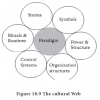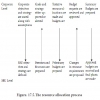Home | ARTS | Strategic Management
|
Organization Design Decisions - Organization Structure And Culture
Strategic Management - Functional Strategy
Organization Design Decisions - Organization Structure And Culture
Posted On :
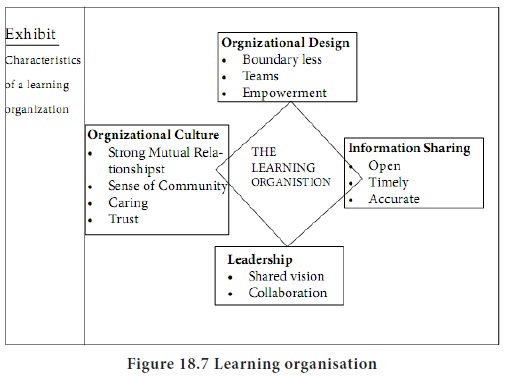
Structuring organization is an engineering job. The way the structures are used determine the effectiveness of an organization structure.
Organization Design
Decisions
Structuring organization is an engineering job. The way the structures are used determine the effectiveness of an organization structure. It implies that the philosophy of management counts. There are two generic of organizational design followed by the philosophical factors.
1. Mechanistic
2. Organic
Table 18-3 describes the two organizational forms. The mechanistic organization is a rigid and tightly controlled structure. It’s characterized by high specialization, rigid departmentalization, narrow spans of control, high formalization, a limited information network (mostly downward communication) and little participation in decision-making by lower-level employees.

Mechanistic types of organizational structures tend to be efficiency machines, well oiled by rules, regulations standardized tasks, and similar controls. This organizational design tries to minimize the impact of differencing personalities, judgments and ambiguity because these human traits are seen as inefficient and inconsistent. Although no pure form of a mechanistic organization exists in reality, almost all large corporations and governmental agencies have at least some of these mechanistic characteristics.
In direct contrast to the mechanistic form of organization is the organic organization, which is as highly adaptive and flexible, a structure as the mechanistic organization is rigid and stable. Rather than having standardized jobs and regulation, the organic organizations is flexible, which allows is to change rapidly as needs require, Organic organizations have division of labour, but the jobs people do are not standardized. Employees are highly trained and empowered to handle diverse job activities and problems, and these organizations frequently use employee teams
The choice of mechanistic or organic structures depends upon several factors as shown in Table 18-4
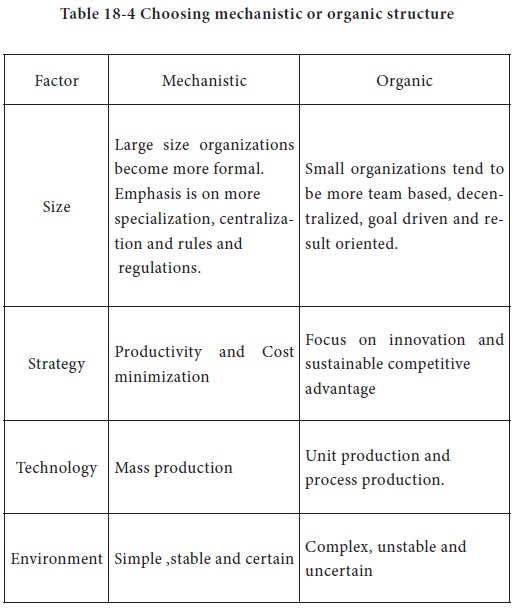
British scholar Woodward categorized organizations based on three distinct technologies The first category, unit production, described the production of times in units or small batches. The second category, mass production described large-batch manufacturing. Finally, the third and most technically complex group, process production, included
continuous-process production. In general, the more routine the technology, the more standardized and mechanistic the structure can be. Organizations with more non-routine technology are more likely to have organics structures.
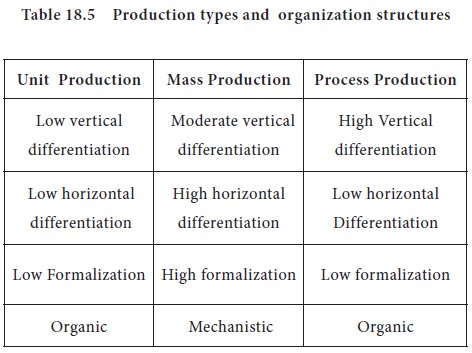
The term was coined by jack Welch, former chairman of General Electric, who wanted to eliminate vertical and horizontal boundaries within GE and break down external barriers between the company and its customers and suppliers. This idea may sound odd, yet many of today’s most successful organizations are finding that they can most effectively operate in today’s environment by remaining flexible, not having a rigid, predefined structure. The boundary less organization seeks to eliminate the chain of command, to have appropriate spans of control, and to replace departments with empowered teams.
By removing vertical boundaries through such structural approaches as cross-hierarchical teams and participative decision making, the hierarchy is flattened. Managers can remove horizontal boundaries by using cross-functional teams and organizing work activities around work processes instead of round functional departments. And external boundaries can be minimized or eliminated by using strategic alliances with suppliers, or value chain management.

Structuring organization is an engineering job. The way the structures are used determine the effectiveness of an organization structure. It implies that the philosophy of management counts. There are two generic of organizational design followed by the philosophical factors.
1. Mechanistic
2. Organic
Table 18-3 describes the two organizational forms. The mechanistic organization is a rigid and tightly controlled structure. It’s characterized by high specialization, rigid departmentalization, narrow spans of control, high formalization, a limited information network (mostly downward communication) and little participation in decision-making by lower-level employees.

Mechanistic types of organizational structures tend to be efficiency machines, well oiled by rules, regulations standardized tasks, and similar controls. This organizational design tries to minimize the impact of differencing personalities, judgments and ambiguity because these human traits are seen as inefficient and inconsistent. Although no pure form of a mechanistic organization exists in reality, almost all large corporations and governmental agencies have at least some of these mechanistic characteristics.
In direct contrast to the mechanistic form of organization is the organic organization, which is as highly adaptive and flexible, a structure as the mechanistic organization is rigid and stable. Rather than having standardized jobs and regulation, the organic organizations is flexible, which allows is to change rapidly as needs require, Organic organizations have division of labour, but the jobs people do are not standardized. Employees are highly trained and empowered to handle diverse job activities and problems, and these organizations frequently use employee teams
The choice of mechanistic or organic structures depends upon several factors as shown in Table 18-4

British scholar Woodward categorized organizations based on three distinct technologies The first category, unit production, described the production of times in units or small batches. The second category, mass production described large-batch manufacturing. Finally, the third and most technically complex group, process production, included
continuous-process production. In general, the more routine the technology, the more standardized and mechanistic the structure can be. Organizations with more non-routine technology are more likely to have organics structures.

Boundary less organization
The term was coined by jack Welch, former chairman of General Electric, who wanted to eliminate vertical and horizontal boundaries within GE and break down external barriers between the company and its customers and suppliers. This idea may sound odd, yet many of today’s most successful organizations are finding that they can most effectively operate in today’s environment by remaining flexible, not having a rigid, predefined structure. The boundary less organization seeks to eliminate the chain of command, to have appropriate spans of control, and to replace departments with empowered teams.
By removing vertical boundaries through such structural approaches as cross-hierarchical teams and participative decision making, the hierarchy is flattened. Managers can remove horizontal boundaries by using cross-functional teams and organizing work activities around work processes instead of round functional departments. And external boundaries can be minimized or eliminated by using strategic alliances with suppliers, or value chain management.
Learning organization
It’s an organization that has developed the
capacity to continuously adapt and change because all members take an active
role in identifying and resolving work-related issues. In a learning
organization, employees are practicing knowledge

Tags : Strategic Management - Functional Strategy
Last 30 days 739 views













